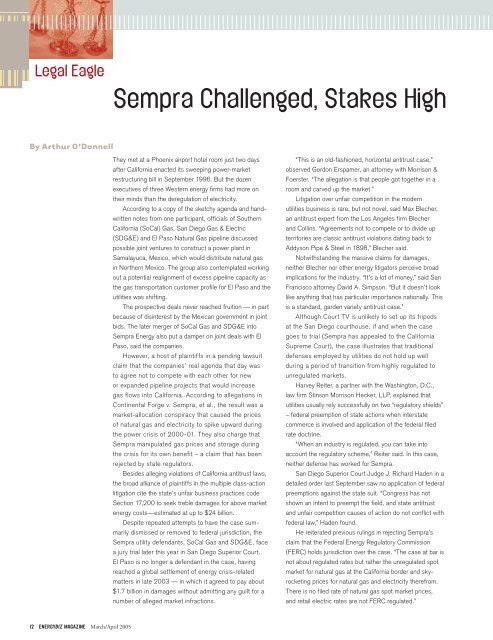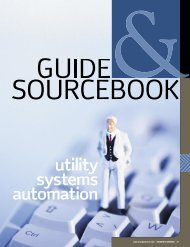CEO Turnover - Description
CEO Turnover - Description
CEO Turnover - Description
You also want an ePaper? Increase the reach of your titles
YUMPU automatically turns print PDFs into web optimized ePapers that Google loves.
Legal Eagle<br />
By Arthur O’Donnell<br />
12 ENERGYBIZ MAGAZINE March/April 2005<br />
Sempra Challenged, Stakes High<br />
They met at a Phoenix airport hotel room just two days<br />
after California enacted its sweeping power-market<br />
restructuring bill in September 1996. But the dozen<br />
executives of three Western energy firms had more on<br />
their minds than the deregulation of electricity.<br />
According to a copy of the sketchy agenda and hand-<br />
written notes from one participant, officials of Southern<br />
California (SoCal) Gas, San Diego Gas & Electric<br />
(SDG&E) and El Paso Natural Gas pipeline discussed<br />
possible joint ventures to construct a power plant in<br />
Samalayuca, Mexico, which would distribute natural gas<br />
in Northern Mexico. The group also contemplated working<br />
out a potential realignment of excess pipeline capacity as<br />
the gas transportation customer profile for El Paso and the<br />
utilities was shifting.<br />
The prospective deals never reached fruition — in part<br />
because of disinterest by the Mexican government in joint<br />
bids. The later merger of SoCal Gas and SDG&E into<br />
Sempra Energy also put a damper on joint deals with El<br />
Paso, said the companies.<br />
However, a host of plaintiffs in a pending lawsuit<br />
claim that the companies’ real agenda that day was<br />
to agree not to compete with each other for new<br />
or expanded pipeline projects that would increase<br />
gas flows into California. According to allegations in<br />
Continental Forge v. Sempra, et al., the result was a<br />
market-allocation conspiracy that caused the prices<br />
of natural gas and electricity to spike upward during<br />
the power crisis of 2000-01. They also charge that<br />
Sempra manipulated gas prices and storage during<br />
the crisis for its own benefit – a claim that has been<br />
rejected by state regulators.<br />
Besides alleging violations of California antitrust laws,<br />
the broad alliance of plaintiffs in the multiple class-action<br />
litigation cite the state’s unfair business practices code<br />
Section 17,200 to seek treble damages for above market<br />
energy costs—estimated at up to $24 billion.<br />
Despite repeated attempts to have the case sum-<br />
marily dismissed or removed to federal jurisdiction, the<br />
Sempra utility defendants, SoCal Gas and SDG&E, face<br />
a jury trial later this year in San Diego Superior Court.<br />
El Paso is no longer a defendant in the case, having<br />
reached a global settlement of energy crisis-related<br />
matters in late 2003 — in which it agreed to pay about<br />
$1.7 billion in damages without admitting any guilt for a<br />
number of alleged market infractions.<br />
“This is an old-fashioned, horizontal antitrust case,”<br />
observed Gordon Erspamer, an attorney with Morrison &<br />
Foerster. “The allegation is that people got together in a<br />
room and carved up the market.”<br />
Litigation over unfair competition in the modern<br />
utilities business is rare, but not novel, said Max Blecher,<br />
an antitrust expert from the Los Angeles firm Blecher<br />
and Collins. “Agreements not to compete or to divide up<br />
territories are classic antitrust violations dating back to<br />
Addyson Pipe & Steel in 1898,” Blecher said.<br />
Notwithstanding the massive claims for damages,<br />
neither Blecher nor other energy litigators perceive broad<br />
implications for the industry. “It’s a lot of money,” said San<br />
Francisco attorney David A. Simpson. “But it doesn’t look<br />
like anything that has particular importance nationally. This<br />
is a standard, garden variety antitrust case.”<br />
Although Court TV is unlikely to set up its tripods<br />
at the San Diego courthouse, if and when the case<br />
goes to trial (Sempra has appealed to the California<br />
Supreme Court), the case illustrates that traditional<br />
defenses employed by utilities do not hold up well<br />
during a period of transition from highly regulated to<br />
unregulated markets.<br />
Harvey Reiter, a partner with the Washington, D.C.,<br />
law firm Stinson Morrison Hecker, LLP, explained that<br />
utilities usually rely successfully on two “regulatory shields”<br />
– federal preemption of state actions when interstate<br />
commerce is involved and application of the federal filed<br />
rate doctrine.<br />
“When an industry is regulated, you can take into<br />
account the regulatory scheme,” Reiter said. In this case,<br />
neither defense has worked for Sempra.<br />
San Diego Superior Court Judge J. Richard Haden in a<br />
detailed order last September saw no application of federal<br />
preemptions against the state suit. “Congress has not<br />
shown an intent to preempt the field, and state antitrust<br />
and unfair competition causes of action do not conflict with<br />
federal law,” Haden found.<br />
He reiterated previous rulings in rejecting Sempra’s<br />
claim that the Federal Energy Regulatory Commission<br />
(FERC) holds jurisdiction over the case. “The case at bar is<br />
not about regulated rates but rather the unregulated spot<br />
market for natural gas at the California border and sky-<br />
rocketing prices for natural gas and electricity therefrom.<br />
There is no filed rate of natural gas spot market prices,<br />
and retail electric rates are not FERC regulated.”















![View From the Trenches [PDF]](https://img.yumpu.com/18854438/1/190x252/view-from-the-trenches-pdf.jpg?quality=85)
